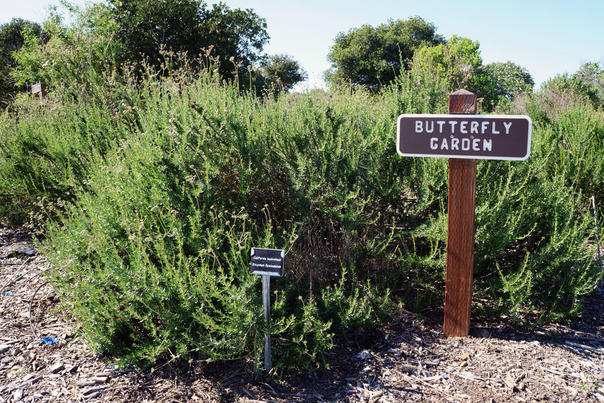Growing Natives Garden Tour 2016
Don Edwards San Francisco Bay National Wildlife Refuge Environmental Education Center (4 photos from 2014)
Garden #70, Alviso
While this garden is open all year round, visiting it during the tour day provides an opportunity to ask the docents about any particularly interesting plants or features.
Address: 1751 Grand Blvd, Alviso (click the address to show it on a map).
Directions: From I-880 or Highway 101, exit on Highway 237 toward Alviso. Turn north onto Zanker Road. Continue on Zanker Road to the Environmental Education Center entrance road (a sharp right turn at Grand Blvd.) The distance from 237 to the entrance road is 2.1 miles. If you've reached Spreckles Ave you've gone too far.
Showcase Features: Volunteers established this garden to provide critical habitat for songbirds and butterflies, and to demonstrate how to garden for wildlife using beautiful California native plants, without the use of herbicides. It contains mature specimens of Ceanothus, fuchsia-flowered gooseberry, pink flowering currant, buckwheat, toyon, and black sage in a naturalistic setting. Among trees, look for California buckeye, western sycamore, Fremont cottonwood, coast live oak, and alder.
Other Garden Attractions: Look for the bioswale between the parking lot and the driveway. Willows, rushes, California fuchsia, California bee plant, and mugwort filter runoff from the surrounding parking lot.
Gardening for Wildlife: The butterfly garden contains milkweed, California buckeye, and other host and nectar plants for swallowtails and western pygmy blue butterflies. Black phoebes, warblers, scrub jays, and mourning doves frequent the songbird garden. Bushtits forage for insects on the branches of several mature coast live oaks, and Anna's hummingbirds find nectar in California fuchsia and hummingbird sage. Jackrabbits and cottontails find cover under mature coffeeberry, toyon, and lemonadeberry. As you walk the garden paths, you may spot a Western fence lizard.
☺ Garden Talk: 10am - 11am Join us for a walk and talk. 11am-12:30pm The North American monarch butterfly and its phenomenal migration are in trouble, but we can help! The Service is busy this spring developing monarch habitat by seeding and planting milkweed. Why milkweed? Milkweed is the host plant for monarchs - the lone plant on which the butterflies lay their eggs in spring and the only food source for monarch larvae. Come out to the Refuge to learn all about monarchs and get a little dirty helping to make a home for them! 1pm - 2:30pm Learn about Leaves - Spring is in the air! Flowers are blooming and new leaves are unfolding. Join Garima wilson to learn about leaf types, arrangement, shapes, and functions along with fun-filled activities. Make a leaf collage, or learn about leaf texture and shape by making leaf rubbings. All ages are welcome. Additional registration required for the above: https://gngt.eventbrite.com.
Years of CA Native Gardening at this Location: 25
Garden Size: 1.5 acre
Designer: Volunteers
Installer: Community Volunteers and USFWS
Click here to display the plant list in a printer-friendly format (from year 2012).
Find us on:

 Donate
Donate









